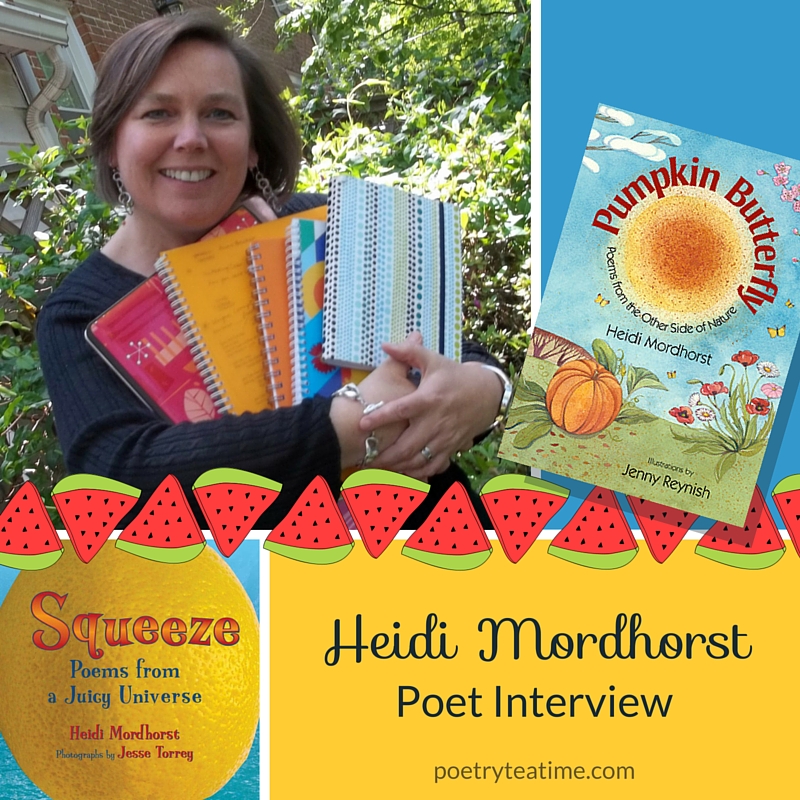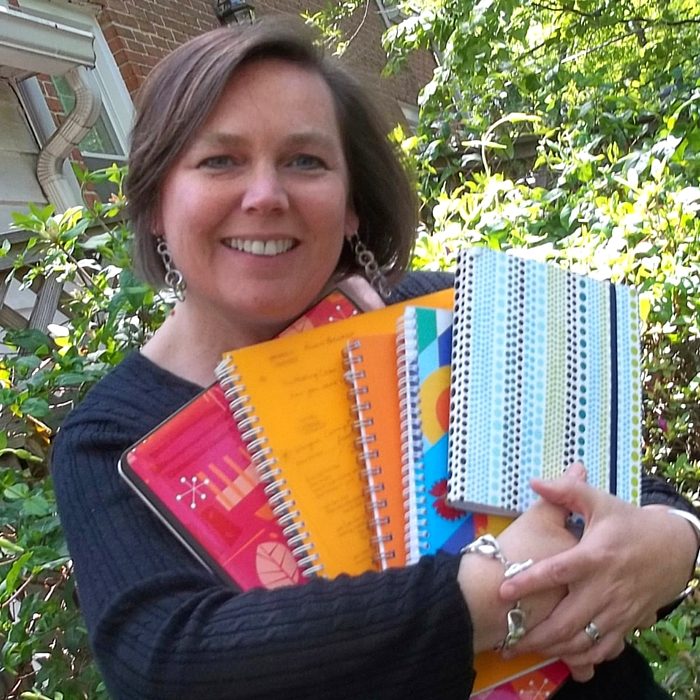Today we’d like to welcome to Poetry Teatime a children’s poet who is known not just for her clever wordsmithing but also her thought-provoking ideas. Heidi Mordhorst has been called a philosopher as well as a poet.* Her books feature beautiful descriptions of nature that often offer a new perspective.
[This post contains affiliate links. Thanks for supporting Poetry Teatime!]
Without further ado, here is Heidi herself to talk to us about writing and poetry.
What encouragement do you have for kids who are just beginning to write?
If you are beginning to write because there are things inside you that are clamoring to get out, you are a born poet! The only encouragement you need is time, space, and a community of readers and writers in which to work. That can be your family, a writing club or class (I went to one at the public library), or you and your best friend.
If you are beginning to write because someone else is asking you to, you may feel like you have nothing to say, or no good way to say it. I have found that EVERYONE has something to say. Put your pencil on the paper and start moving it—or if handwriting is hard for you, use a keyboard, or ask someone to write for you. Then just start! Start writing, start typing, start talking.
At first what you’re writing might not be important, but if you keep going, in three or four minutes something important inside you will realize it’s getting a chance to speak, and you will find that you DO have something to say. This true thing inside you almost always finds its own good way to be said, but if not, there are many ways to go back and make your true thing sound better. And sometimes it’s enough for it just to be TRUE. Writers often write only for themselves!
Great advice, Heidi! It sounds a lot like freewriting in the Brave Writer lifestyle. On another note, you’ve mentioned before that music always mattered to you. Can you elaborate on how music has influenced your writing process?
I’m sure that being surrounded by music—with and without words—helped me learn ways to bring rhythm and pattern to my writing. When I think I’ve finished a poem, I have to read it out loud (you know, the way we play and sing music) to hear if it’s working. My music-trained ears almost always notice right away when something isn’t right, where there’s a jarring or breaking of pattern or momentum in my lines. That’s an important tip for young writers of poetry or any kind of writing: READ IT OUT LOUD to hear how it sounds. You can also have someone else read it to you.
We love to pair tea and food with poetry. Many of your poems mention food—for example, your book Pumpkin Butterfly features wild strawberries, lemons, and cherries. How can poetry and food complement each other? Do you have any favorite food/poem pairings, either of your own or of others’ work?
A tea party is a special way of enjoying food and drink that gives extra weight and importance to the flavors and the company. Poetry is a special way of enjoying words and ideas that gives extra weight and importance to the meaning and the metaphor. They go together beautifully!
My family just celebrated the Summer Solstice with a big evening picnic in a park where we always serve watermelon—one of the very best flavors of summer. Here is a watermelon poem that goes with my poem from Pumpkin Butterfly called “Winged Solstice.”
Ode to a Watermelon
by Pablo Neruda
Round, supreme, celestial watermelon
The fruit of the tree of thirst
Green whale of summer.
Here’s a delicious recipe for a watermelon-themed summer teatime treat:
- Cut watermelon and feta cheese in equal-sized cubes.
- Stack a watermelon cube, a feta cube and a mint leaf.
- Skewer the stack on a toothpick and enjoy how beautiful it looks before enjoying how exciting it tastes!
Thanks for the recipe! We can’t wait to try it!
Although many of your poems are fun, sometimes your poetry deals with tough emotions such as in “How to Run Away” from Squeeze. What is the place of darkness, sadness, anger, or difficult emotions in children’s poetry?
It is exactly the same place of those difficult but true emotions in children. I learned a very important lesson as a parent which has served me well as a teacher: children’s brains may not be as big and mature and sophisticated as the brains of adults, but their emotions are just as big and intense and powerful as the emotions of adults. Experiences of poetry that go beyond goofy and gross are essential for kids to understand how “the best words in the best order” can express and echo their true feelings, which includes but is not limited to goofy, gross glee.
Most of your poems are written in free verse, with a bit of rhyming here and there. What do you love about writing free verse poetry? Are there any other poetic forms or styles you experiment with?
Although many of my poems must be termed “free verse,” it’s usually easy for an attentive reader to find the internal structure of an individual poem. A good example is “Frozen Angels”—it’s not written in a recognized verse form, but you can see and hear the form of the poem: four 6-line stanzas, with lines 2, 3 and 6 short and “broken,” lines 3 and 6 rhyming, and line 6 always ending in “snow.”
There’s nothing free in that verse…except that I created it! I love listening the rhythms of the words and ideas that catch my notice and then organizing them into the form they are looking for, but I also really love writing in traditional forms. Too much freedom hardly ever works for me, and hewing to a traditional form is good practice for any writer.
Can you tell us anything about projects you’re working on at the moment?
My project for the summer is to get back into regular writing! I taught a new grade level this year and getting on top of that really cut into my writing time and temper.
I’m using a great book to kickstart some new work—many of your readers will enjoy it too. It’s called Rip the Page! by Karen Benke and I’m having a great time playing along with her ideas.I would welcome seeing work from any of your readers! Just click the link on my blog to email me.
Thanks for inviting me to your Poetry Teatime!
Thanks for joining us, Heidi!
To find out more, here is the link to Heidi Mordhorst’s website and her blog My Juicy Little Universe. Also, her two books can be found here: Squeeze and Pumpkin Butterfly.

*Heidi Mordhorst was called “a philosopher as well as a poet” in an interview with Kate Coombs on The Book Aunt.


